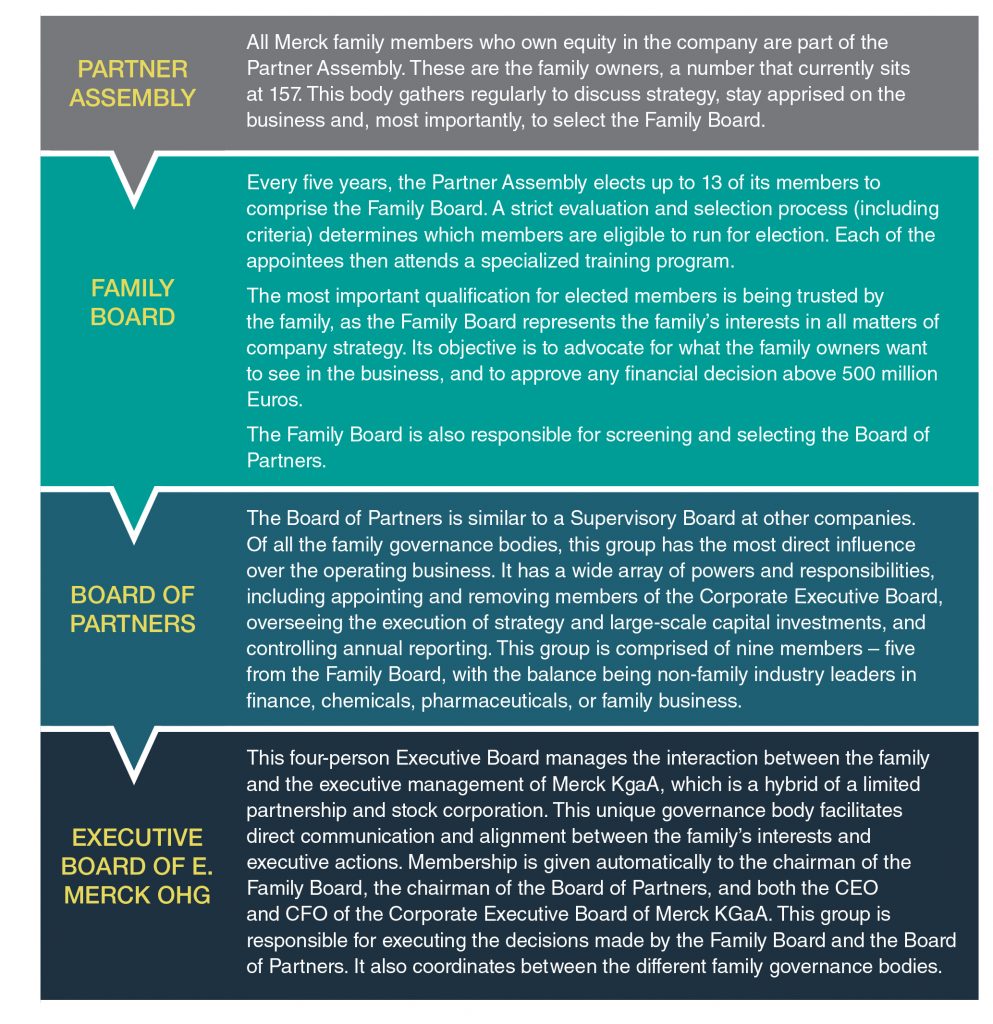It was in 1668 that a young apothecary, Friedrich Jacob Merck, purchased a small pharmacy in Darmstadt, Germany. More than 350 years later, his descendants still own that same pharmacy – along with the oldest pharmaceutical and chemical company in the world. Today, Merck has 57,000 employees across 66 countries and annual revenues (2019) of nearly USD 20 billion. It’s a global leader in science and technology.
And it’s also one of the oldest family-run businesses in existence.
How has the Merck family pulled it off? How did it take a single, small town pharmacy and build it into a global enterprise, while also maintaining majority ownership for 13 generations? It’s a fascinating story – one we explored last Fall in our original profile of the Merck family and its iconic business. 
The more we learned about the Mercks, the more curious we became. We discovered that the Merck family tree is constantly growing in both size and complexity. Add in owning a multi-faceted company in a rapidly transforming industry – and it makes for a complicated puzzle.
It begs the question: how does the family “keep it all together?”
So we’ve decided to go further in understanding the Merck family’s success. In a series of regular scheduled updates to our original story, we’ll explore some of Merck’s best practices in more detail.
Our first instalment focuses on family governance structures – and how Merck has used these to cultivate (and sustain) unity and stability within the family.
Building strong foundations amidst rapid growth
‘Professionalizing’ the Merck family hasn’t been simple by any stretch, but the family has put in the time and the resources over the years to getting it done. It’s clear now that the Mercks’ dedication and commitment have enabled them to develop, maintain, and evolve a family governance system that’s uniquely their own.
Emanuel Merck, great-grandson of Friedrich, started by transforming the pharmacy into a research-based industrial company in 1827. The business quickly grew from local dispensary to international operation. Along with this growth came a need to set clear ground rules for the relationship between the family and the business. One of Emanuel’s first moves was to establish a formal partnership with his three sons in 1850. Merck was now an enterprise with multiple partners.
The partnership was a great start. It laid a foundation for the many generational transitions that followed, and it suited the family’s circumstances for the time being. Ownership and leadership were clear. But both the business and the family were also expanding rapidly. Merck would soon need more formal structures to accommodate the growing complexity.
Formal systems can be an obstacle for many multi-generational family businesses. Even when rules and processes are in place, the dynamics of the family itself often dominate. While studies show many family businesses experience less conflict than their non-family counterparts, when the conflict does occur it can be far more intense. The causes are usually similar: disputes over strategy, money, status, authority.
What keeps conflict resolvable and in check in a non-family business is something many family businesses lack: formal boundaries. No family, especially one in business together, could go 350 years without a few differences of opinion and difficult conversations along the way. The Merck family knew that luck and their best intentions would only go so far, so they made a choice.
They made a strong commitment to preventive measures.
They began to set boundaries. They developed a system, and put it into action. At Merck, the commonly disputed topics like strategy, money, status, and authority are all policy-driven, with clear ‘guardrails’ in place to keep them on track. Disputes get resolved methodically before they become catastrophes and overpower the family or the business.
It’s one of the key reasons they’ve endured for 13 generations. So let’s go a bit deeper.
Key principles of Merck’s family governance

1. The Family Constitution
All family owners are bound to the conditions of the Merck ‘family constitution’ – a document first drafted in 1888 that continues to this day. The document currently sits at 150 pages, is regarded as law by the family, and is updated regularly. Its main purpose is to formalize the strict separation of operational management and ownership – along with the key structures, ground rules, legal rights, relationships, protocols and shared objectives for the family. It also clearly defines roles and responsibilities for family members.
The constitution enables key decision-making to be driven by policy, which minimizes the potential for conflict. It operates in a rollover fashion, with the current version in place until 2040. Family owners can only opt out when the contract is up for renewal. No members exited at the time of the last renewal, reaffirming the commitment and unity in the Merck family.
2. Four distinct governance bodies
Merck has a unique dual board system, carefully designed to suit its needs. The operating business is controlled by a corporate board of non-family members, while a family-only board serves in a supervisory capacity. (We’ll further explore this pioneering system in a later segment.) For now, we’ll focus on the governance system of the family-only side.
The Merck family owns roughly 70% of the business via its holding company, E. Merck OHG. The family owners divide that 70% amongst themselves with individual participation certificates. No single family member owns more than 2-3% of the total shares. The Family Constitution specifies that family members cannot sell their equity participation.
Beyond this, Merck has created (and continually refined) an intricate, multi-layered family governance system with four distinct bodies:

At first glance, this structure has many intricacies and moving parts. You might even call it complex. Most importantly, it’s highly customized to meet the unique needs of the Merck family. Each governance body was developed at a different time in Merck history to fill a particular role or gap in their system. The family continually adapts and improves their structures as needed and considers no arrangement to be finalized or perfected. It’s in constant evolution – and it works for them.
Moreover, Merck family owners approach their roles with a unique perspective. They don’t refer to themselves as company shareholders. Rather, they consider themselves “trustees of the family business.” Family members aren’t paid a salary. Instead, they receive annual dividends. They reinvest everything they earn from the business back into the business.
3. Family Meetings
Merck hosts two formal Partner Assembly meetings each year, attended by family owners only. One is held shortly before the companywide annual general meeting and provides an overview of the business over the past year. This meeting also permits discussion of strategic issues and other important matters. The second meeting is dedicated to a different business topic each year, and is an opportunity for family owners to engage and share thoughts on business and strategy. By participating in these events, family owners reaffirm their strong commitment to remaining active in the Merck family business. The meetings also enable owners to grow together and maintain personal relationships, which the Merck family highly values.
The freedom of formal arrangements
Building a structured family governance system has provided the Merck family with clarity, consistency, and durability. It has also afforded family owners the freedom to focus on the bigger picture. By eliminating concerns about how the family will operate and interact, little time or resources are wasted in dealing with the fall-out of conflict or disputes. The family governance system has the appropriate guardrails in place to take care of that.
Instead, the family can focus on making strides in their industry, planning for their future, and optimizing their family legacy. Merck family governance is complex. They’ve carefully constructed it, and updated it along the way. Today, 13 generations of Merck family members are a part of that system. This iconic family business shows us that while each family has distinctive needs, there is much to be gained from developing strong governance.
Questions for you to consider:
- Is a family constitution (or “contract”) something you’ve explored for your family?
- What structures are in place within your own family to give everyone clarity on their role in the business?
- What areas of family governance would be beneficial for you to focus on?

› The level of “stewardship” that we see with the Mercks in this story exemplifies a value that many European families hold sacred. It sets a strong example for families in Canada and the importance of prudently managing their capital.
› Governments in Europe actively support and protect the ability for families to succeed through multiple generations. It’s why families with long (and sustained) legacies are often European-based. It’s something we’d like to see more of in Canada – for business families here to be acknowledged and appreciated for what they’ve accomplished and how they contribute to the fabric of the country in multiple ways.
› Jessika’s story mentions how “exits” by family owners are rare at Merck, while they are more common in Canada. The maximum ownership stake of 2-3% for the Mercks may make exiting more manageable among the family units.
› We should applaud the Mercks for their attention to the Family Constitution. They seem to approach it as a “living guide and vision for the family” instead of a simple to-do to “check off the list.” By each generation adding to the Constitution over time, the family creates a deeper legacy and almost a “blood bond” with the family enterprise. Very impressive.
› Finally, the Mercks’ discipline in its governance protocols is a reminder to its family members that they each have a role based on their capabilities and not their birthright. In our experience in Canada, successful families pay close attention to evaluating their next generation family members sooner rather than later in order to best position them to be good owners and leaders down the road. This is a key ingredient in enduring business families.
Future topics we’ll explore in the Merck family story:
1. The indispensable role of non-family members in Merck’s business.
2. The benefits (and oddities) of Merck’s unique dual-board system.
3. The systematic (and often cut-throat) development of next-generation leadership at
Merck.
Download and view as a PDF here.
Jessika McQueen is a freelance writer based in Toronto.
